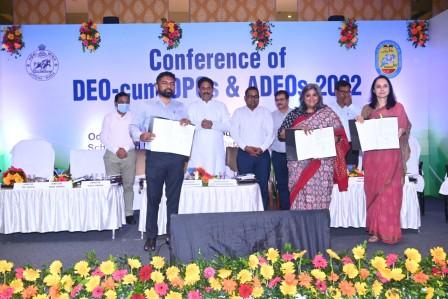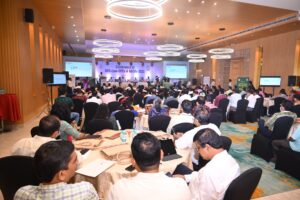Odisha Plus Bureau
Odisha government has taken a policy decision to integrate gender equity curriculum into syllabus prescribed for government schools in the State.

The curriculum will be integrated into the Social Studies syllabus for adolescent boys and girls from Grades 6 to 10 in over 18,000 elementary and 5,000 secondary schools in Odisha by end of August 2022.
In this regard, the Department of School and Mass Education today partnered with ‘Breakthrough’ and the ‘Abdul Latif Jameel Poverty Action Lab’ (J-PAL), South Asia. A MoU was signed today in presence of School and Mass Education Minister Samir Ranjan Das, Breakthrough CEO Sohini Bhattacharya and J-PAL, South Asia, Executive Director Shobhini Mukerji.
At the signing ceremony, Minister Dash said, “Gender equality is very important. We are working on it.”
Bishnupada Sethi, Principal Secretary to Odisha government’s School and Mass Education Department, said, ”The inclusion of gender dimension in State school curriculum is a very remarkable step. Despite the gains and progress India has made in gender equality, there are issues that continue to remain unaddressed even today. This intervention can bring about positive changes in the way we look at gender issues. And schools are the best places to start these conversations. We will have wide-ranging topics that will be covered in schools as part of this programme to build a gender-equal world.”
Designed by NGO Breakthrough, the curriculum uses interactive classroom discussions to encourage adolescent boys and girls to reflect on culturally embedded gender norms, roles, and discriminatory practices to transform their gender attitudes, aspirations, and behaviors.
The curriculum was first evaluated by J-PAL South Asia in 314 government schools in Haryana and was found to shift the gender attitudes and behaviors of both boys and girls and lead students to enact more gender-equitable behaviors. The curriculum has since been introduced in multiple states in India, including Punjab where it is currently reaching 600,000 students annually in government schools across the state.

In Odisha, Breakthrough will work with the Department of School and Mass Education to contextualize and integrate the curriculum into the syllabus, train teachers, key departmental personnel, and conduct gender sensitization workshops with teachers across 23,000 state-run schools. The program will also leverage the Digital Infrastructure for School Education (DIKSHA) – Government of India’s open-access education technology platform, to train teachers, receive feedback from them, and engage parents in the sensitization process as well.
Sohini Bhattacharya, CEO, Breakthrough, said, “Breakthrough is honored to partner with the Government of Odisha and J-PAL South Asia to bring about systemic and lasting change in gender behaviors. Breakthrough, over the last 22 years has been working towards making violence and discrimination against women and girls unacceptable. We know that gender perceptions get formed at a young age and therefore, we need to ensure that children, especially those between the ages of 10-15 have access to the right information related to gender equality, legal rights, and healthy gender behaviors. The Gender Equity program aims to achieve this and has played a significant role in promoting gender-equitable behavior among school children.”
J-PAL South Asia will conduct independent monitoring activities to ensure that the programme is achieving its objectives and to generate insights for sustained, high-quality government implementation of the syllabus.
Shobhini Mukerji, Executive Director of J-PAL South Asia, said, “Adolescence presents a crucial window of opportunity to change even deeply-rooted norms and instill more progressive gender attitudes. The Government of Odisha’s decision to introduce Breakthrough’s innovative gender equity curriculum across public schools in the state has opened the doors to a more equitable society, in which both girls and boys can imagine a more equal future for themselves.”
The State government has decided to introduce Gender Equity Programme to help it in achieving the Sustainable Development Goals (SDG) 4 and 5 of quality education and gender equality.
Besides bringing positive gender attitudes and behaviours in both boys and girls, the expected outcomes of the programme include adolescents practicing gender equitable behaviours, teachers’ involvement to build a gender equitable school, parents value their daughters and invest in their education, girls having choices for their education and work participation, retention of girls in schools for more number of years leading to reduction in girls’ drop out, increase in the age of marriage and age of first child birth, improved sex ratio and increased labor force participation by women.
“Odisha is already doing a lot of work on girls’ education. This intervention is another feather in its cap,” opined Anupam Saha, State Project Director, OSEPA.
Tags: #Breakthrough #Education #GirlsEducation #JPALSouthAsia #childbirthratio #GenderEquityProgramme





























